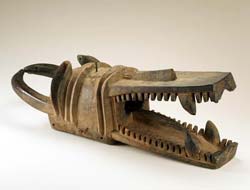
Biting beasts refers not to a specific animal but to our perception of an animal's behavior. We see open jaws and sharp teeth and think, it's going to bite me or eat me. And, it is true the devouring animal image is meant to scare the outsider or those lacking knowledge. Masks used in the initiation rites that guide youths into adulthood symbolically devour and give birth to knowledgeable adults. Similarly, threatening masks can protect the village from spiritual harm, illness or physical threats; their secret--they are not harmful to their people.
Some threats are real but controlled. For the Isoko peoples, the ivri (2005-6-1) is a personal shrine that refers both to a protective deity and to the idea of personal success. The figures merge human and animal traits with the human image riding an open-mouthed beast. The teeth and horns are in keeping with their role as protective combatants for their owners.
 Similarly, the motifs on the metal containers refer to the ruler's power of life and death, both as a judge and as a leader of armies. The footed vessel from the Benin kingdom (acc. no. 85-19-14) has a handle in the form of a python--the king of snakes--biting a human being, signifying the ruling oba's exclusive right to take human life. Similarly, the motifs on the metal containers refer to the ruler's power of life and death, both as a judge and as a leader of armies. The footed vessel from the Benin kingdom (acc. no. 85-19-14) has a handle in the form of a python--the king of snakes--biting a human being, signifying the ruling oba's exclusive right to take human life.
 The lid of the Asante container (acc. no. 97-9-1) features a leopard attacking an antelope and two birds facing in opposite directions, a motif associated with royalty. The saying, "After the leopard has had its fill, the birds can eat," refers to the power and respect given to a ruler. This is particularly appropriate for this type of vessel, which was used to hold gold dust and precious beads and was owned by Asante kings and chiefs. The lid of the Asante container (acc. no. 97-9-1) features a leopard attacking an antelope and two birds facing in opposite directions, a motif associated with royalty. The saying, "After the leopard has had its fill, the birds can eat," refers to the power and respect given to a ruler. This is particularly appropriate for this type of vessel, which was used to hold gold dust and precious beads and was owned by Asante kings and chiefs.

Helmet mask
Loma peoples, Liberia and Guinea
Mid- to late 20th century
Wood
Gift of Mrs. Lawrence Richmond, 78-10-16
|

Ivri shrine figure
Isoko peoples, Nigeria
19th to 20th century
Wood
Gift of Walt Disney World Co., a subsidiary of The Walt Disney Company, 2005-6-122
|
|
|
|